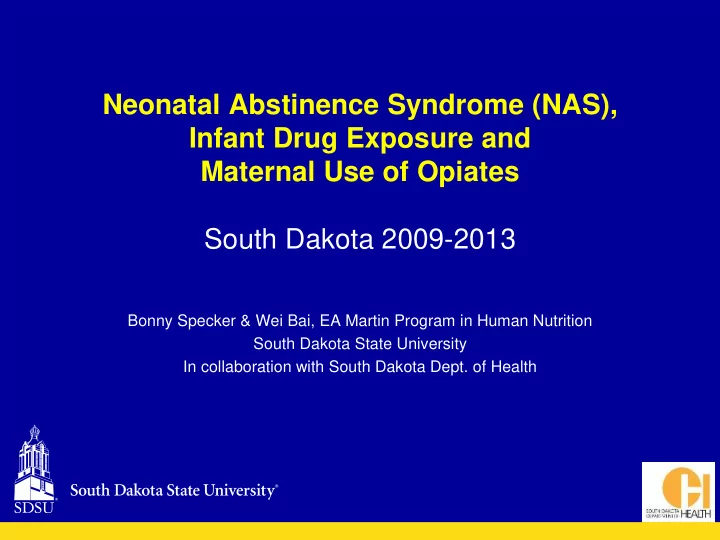

Neonatal Abstinence Syndrome (NAS), Infant Drug Exposure and Maternal Use of Opiates South Dakota 2009-2013 Bonny Specker & Wei Bai, EA Martin Program in Human Nutrition South Dakota State University In collaboration with South Dakota Dept. of Health
Objectives To determine the incidence of NAS and infant drug exposure in South Dakota using hospital discharge data and to describe populations at increased risk.
Definitions Neonatal Abstinence Syndrome (NAS): • Newborn drug withdrawal syndrome (ICD-9 code 779.5) • Narcotics affecting fetus or newborn via placenta or breast milk (added per CDC communications; ICD-9 code 760.72)
Definitions Infant Drug Exposure: • Newborn drug withdrawal syndrome (ICD-9 779.5) • Narcotics affecting fetus or newborn via placenta or breast milk (ICD-9 760.72) • Hallucinogenic agents affecting fetus or newborn via placenta or breast milk (ICD-9 760.73) • Cocaine affecting fetus or newborn via placenta or breast milk (ICD-9 760.75)
Definitions Maternal Opiate Use: • Opioid type dependence (ICD-9 304.0) • Sedative, hypnotic or anxiolytic dependence (ICD-9 304.1) • Combinations of opioid type drug with any other drug dependence (ICD-9 304.7) • Combinations of drug dependence excluding opioid type drug (ICD-9 304.8) • Non-dependent opioid abuse (ICD-9 305.5) • Non-dependent cocaine abuse (ICD-9 305.6) • Long-term use of methadone or other opiate analgesics ( ICD-9 V58.69) limited to women discharged with complication of pregnancy (ICD-9 630-679)
NAS & Infant Drug Exposure SD Cases, 2009-2013 5 Newborn drug withdrawal NAS 23 Narcotics affecting fetus or newborn Hallucinogenic agents 80 38 Cocaine affecting fetus or newborn
Maternal Opiate Use * SD Cases, 2009-2013 Opioid type dependence 32 Non-dependent opioid 23 abuse Long-term use of methadone or other opiate 165 analgesics * Only categories with more than 5 cases are shown
Why do we use rates? Questions: Has the occurrence of NAS changed over time? Are certain populations at greater risk than other populations? To look at changes over time or to compare populations we need to know how many infants are at risk of being exposed. We calculate a rate – in this case we divide the number of infants exposed by the total number of births.
Trends Over Time Significant increasing trend in opiate use 12 NAS Incidence (per 1,000 births) Infant Drug Exposure 10 Opiate Use 8 6 US Opiate 2009 rate 4 US NAS 2009 rate 2 0 2009 2010 2011 2012 2013
Exposure by Mother’s Age Significant differences by mother’s age 8 Incidence (per 1,000 births) Only available for maternal opiate use 6 4 2 0 <20 20-24 25-29 30-34 35-39 40+ Mother’s Age (year)
Exposure by Race Significant race differences in all 3 categories 8 NAS Incidence (per 1,000 births) Infant Drug Exposure 6 Opiate Use 4 2 0 White Am Indian Black
Exposure by Region of the State Significant regional differences in all 3 categories 8 NAS Newborn Drug Exposure Incidence (per 1,000 births) Opiate Use 6 4 2 0
Summary Based on 2009-2013 hospital discharge data: • Occurrence of NAS & infant drug exposure have not changed significantly; maternal opiate use has increased. • Majority of maternal opiate use is with long-term use of methadone or other opiate analgesics [i.e., codeine (Atasol, Tylenol 2, 3 or 4), morphine, methadone, meperidine (Demerol), hydromorphone (Dilaudid), oxycodone (OxyContin, Percocet)].
Summary • Highest incidence of maternal opiate use is among women aged 35-39 years • Significant race differences: • Blacks have the highest rate of NAS • American Indians have the highest rates of infant drug exposure & maternal opiate use • Significant regional differences: • Central region has the highest NAS & infant drug exposure rates • Sioux Falls MSA has the highest maternal opiate use
Thank you Audrey German for your work on reducing maternal drug usage.
Recommend
More recommend